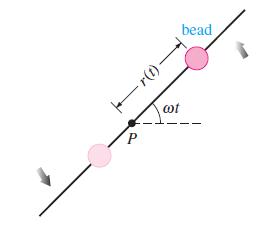A bead is constrained to slide along a frictionless rod of length L. The rod is rotating
Question:
A bead is constrained to slide along a frictionless rod of length L. The rod is rotating in a vertical plane with a constant angular velocity ω about a pivot P fixed at the midpoint of the rod, but the design of the pivot allows the bead to move along the entire length of the rod. Let r(t) denote the position of the bead relative to this rotating coordinate system as shown in Figure 5.R.2. To apply Newton’s second law of motion to this rotating frame of reference, it is necessary to use the fact that the net force acting on the bead is the sum of the real forces (in this case, the force due to gravity) and the inertial forces (coriolis, transverse, and centrifugal). The mathematics is a little complicated, so we just give the resulting differential equation for r:
![]()
(a) Solve the foregoing DE subject to the initial conditions r(0) = r0, r'(0) = v0.
(b) Determine the initial conditions for which the bead exhibits simple harmonic motion. What is the minimum length L of the rod for which it can accommodate simple harmonic motion of the bead?
(c) For initial conditions other than those obtained in part (b), the bead must eventually fly off the rod. Explain using the solution r(t) in part (a).
(d) Suppose ω = 1 rad/s. Use a graphing utility to graph the solution r(t) for the initial conditions r(0)
0, r'(0) = v0, where v0 is 0, 10, 15, 16, 16.1, and 17.
(e) Suppose the length of the rod is L = 40 ft. For each pair of initial conditions in part (d), use a rootfinding application to find the total time that the bead stays on the rod.

Step by Step Answer:

A First Course in Differential Equations with Modeling Applications
ISBN: 978-1111827052
10th edition
Authors: Dennis G. Zill




